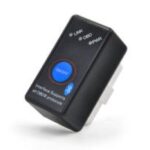Locating the OBD2 port in your Renault Trafic (2001-2014) can be tricky. This guide provides clear instructions and images to help you find it quickly. Knowing where your OBD2 port is located is crucial for vehicle diagnostics and maintenance.
The OBD2 connector is located beneath the steering wheel.
You’ll need to unclip a plastic cover to access the port. The connector is positioned directly behind this cover.
This is the OBD2 connector. Once the plastic cover is removed, you should easily see the 16-pin connector. (Images provided by thierry 34430)
Renault Trafic and OBD2: What You Need to Know
The Renault Trafic, a popular light commercial vehicle, has been equipped with OBD2 ports since 2001. The On-Board Diagnostics II (OBD2) system allows you to connect a diagnostic scanner to retrieve vehicle data, troubleshoot issues, and monitor performance. This standardized system makes diagnosing problems much easier for both professionals and DIY enthusiasts.
Why is Finding the Renault Trafic OBD2 Port Important?
Accessing the OBD2 port is essential for:
- Diagnosing engine problems: Retrieve fault codes (DTCs) to pinpoint the cause of warning lights or performance issues.
- Monitoring vehicle performance: Track parameters like fuel economy, engine speed, and emissions.
- Performing emissions tests: Ensure your vehicle meets regulatory requirements.
- Customizing vehicle settings: Certain software allows for adjustments to specific vehicle parameters (depending on the model and software).
Renault Trafic Generations: A Brief Overview
The Renault Trafic has seen several iterations throughout its history. This guide specifically addresses the second generation (2001-2014). Understanding the evolution of the Trafic helps contextualize the importance of the OBD2 system in modern vehicle maintenance.
- First Generation (1980-2000): Predecessor to the model covered in this guide.
- Second Generation (2000-2014): This generation introduced more modern engine options and design features, including the standardized OBD2 port.
- Third Generation (2014-present): Features further advancements in technology and design.
Finding the OBD2 Port in Other Renault Vehicles
While this guide focuses on the Renault Trafic (2001-2014), the OBD2 port location can vary slightly across different Renault models. Consulting your vehicle’s owner’s manual is always recommended. There are also online resources and mobile apps that can help you locate the OBD2 port in various car models.
Conclusion
Locating the OBD2 port in your Renault Trafic (2001-2014) is a straightforward process once you know where to look. This guide, with its clear images and instructions, ensures you can quickly access the port for diagnostics and maintenance. Regularly checking your vehicle’s systems through the OBD2 port can contribute to its longevity and performance.
